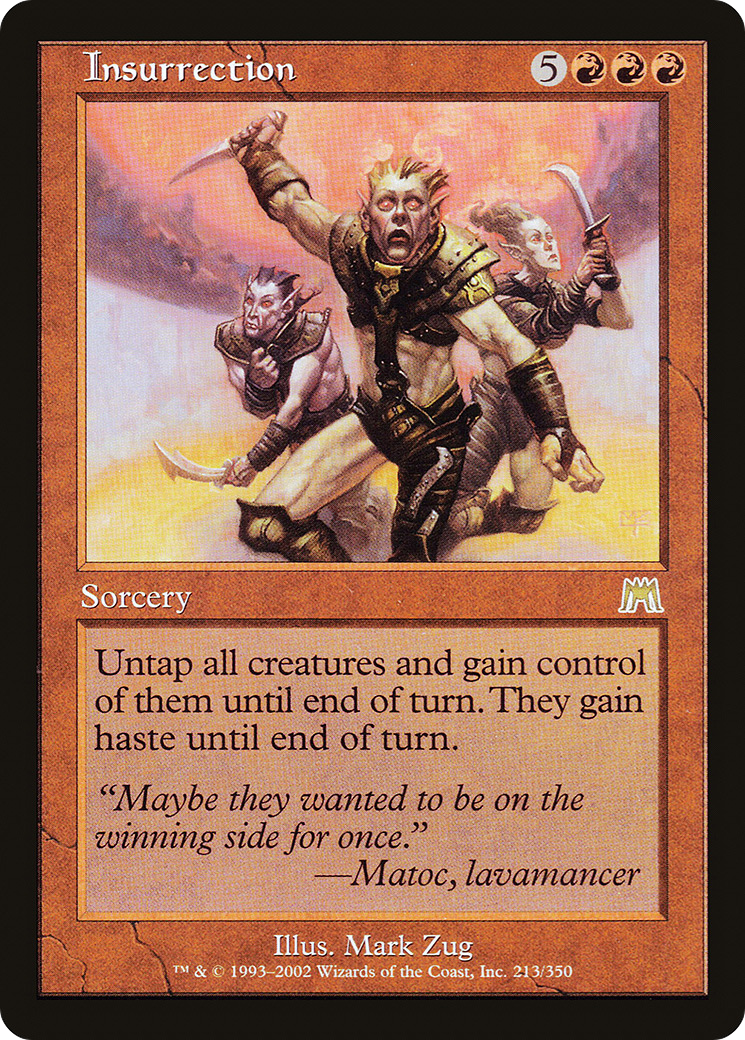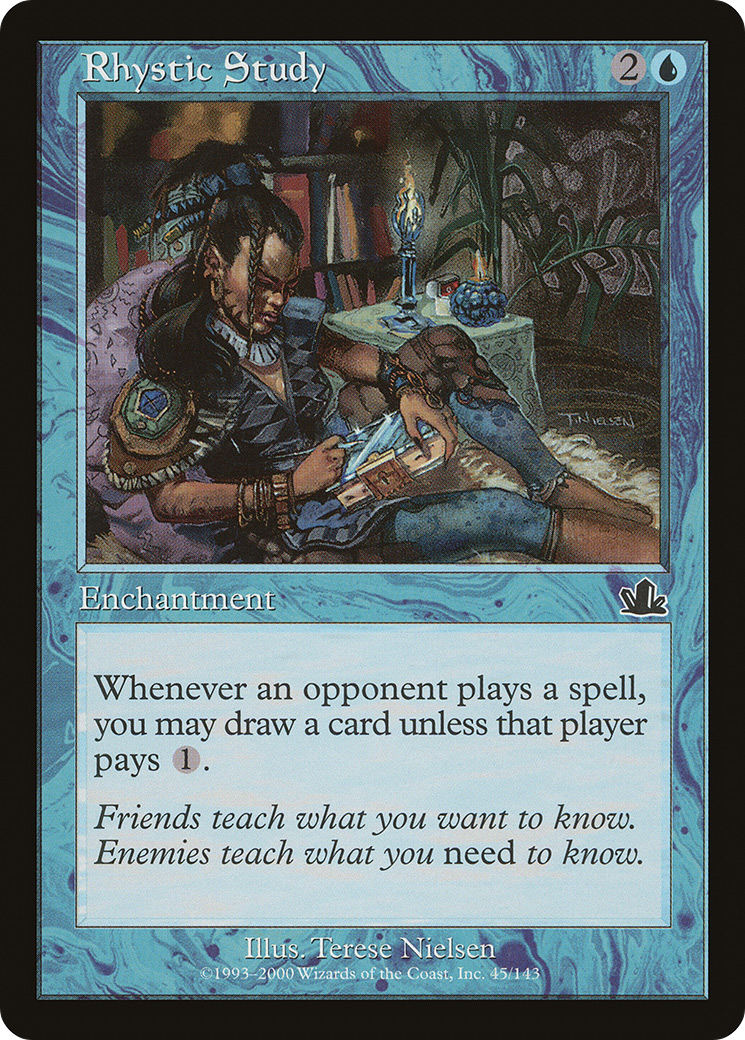MULTIPLAYER BATTLE BOX UPDATE
Battle Boxing is my favorite way to play Magic: the Gathering, and today I’ll be sharing much of what I’ve learned about playing and tuning my personal Battle Box, “The Danger Room,” for multiplayer games with friends.
Let’s start with the basics (and non-basics) of Battle Box as a format….
BATTLE BOX IS A GREAT MANA SYSTEM FOR CASUAL PLAY
The concept behind Battle Box is to play a form of Magic where the Lands each player will use start in exile (rather than mixed into a deck) and players are allowed to play one land per turn from exile.
Originally, I gravitated toward using the Invasion ETB (Enters the Battlefield) tapped lands and one of each Basic.
I’m also a big fan of the Vivid lands in Battle Box. Since mana fixing and land drops are essentially “free” from exile, I like having some kind of functional drawback applied to the mana fixing element. Each player begins the game with access to the same ten lands in exile, but the mana fixing lands ETB tapped.
The other end of that equation, where lands start in exile and are absent from the big deck of cards, is that players always draw from the “Battle Box” big stack of spells each turn. So, not only is mana screw eliminated from games outright, but also mana flood. It’s a wonderful system for playing fun, balanced games of casual MTG.
Players draw from the Battle Box stack and play their designated lands from exile and thus everybody in the game, 1v1 or multiplayer, always hits their land drop and draws a spell each turn.
While I do still enjoy playing with my original Invasion ETB tapped dual lands, I’ve mixed things up a little bit based on my experience. I play a lot of heads up Battle Box with my wife in the evenings and I noticed that she, as a newer player to the game, spent a lot of mental energy on land sequencing order. Personally, I like the nuance and strategy of sequencing land drops but it tends to come very easy to me as a highly experienced player and so I wanted to make things a little easier for her to enjoy the games.
I came up with the concept of designing our own Battle Box lands, called Towns.
Towns are kind of like “easy mode” for mana sequencing – especially in 1v1 duels, however it is also my observation that Towns have been an extremely fun and practical innovation for playing with my stack in a multiplayer setting. Making the fixing a little bit less restrictive opens the door to play more double and triple color spells in the stack up and down the curve and having that design element of the stack be less restrictive to cast drawn spells.
Another option that’s been suggested to me (if you don’t want to invent your own unique cards to play Magic with!) is to simply use Reflecting Pools and Basics.
The biggest drawback of this system in my estimation is needing 20 Reflecting Pools to round out the mana bases for four players! I’m all about playing Magic on a budget and getting the most out of the time I have to play at a reasonable cost. I’ve also tried out Vivid Lands and Thriving Lands but prefer the simplicity and elegance that Towns provide in my games.
My favorite element of Battle Box is that it essentially allows players to design their own format to play and there’s no right or wrong way to do it. Ultimately, it boils down to whatever you and your friends enjoy the most which makes it a great kitchen table or LGS play experience.
I really like how Towns play, especially in multiplayer – since it opens up all double color options to a spellcaster for the drawback of playing a single land tapped.
WHAT MAKES BATTLE BOX A GOOD MULTIPLAYER FORMAT?
One thing I’ve noticed as I’ve gotten older, continue to play Magic, and as the incentives for competitive play dwindle; I found myself less and less interested in competing in tournaments. I still love to play Magic, but I tend to find myself gravitating toward less competitive modes of play and more about wanting a quality game.
When I was a Pro Player back in the heyday of MTG events, it felt like there was a reasonable amount of information to learn and keep up with but with so many new sets and designs constantly being released I found myself overwhelmed and the task of collecting so many new cards to build decks was restrictively expensive.
When I played competitively I was always the kind of player who liked to identify a strategy I enjoyed and stuck with it long enough to play it well in events. My observation of current Magic tournament formats is that new cards and frequent bans tend to quickly displace strategies and would lead to me needing to build a new deck every month to keep up with the Jones’.
I’m 40, married, and Magic is a hobby that I enjoy. At 40, and with responsibilities and commitments, I simply don’t have the time or energy to invest into playing travel tournaments anymore. Maintaining and sharing a Battle Box is more at my speed of Magic now.
One big selling point of building a Battle Box is that it doesn’t need to be replaced ever! In fact, I tend to view my Battle Box as an opportunity to play with and collect all my favorite cards I’ve collected and enjoyed playing with over the years that have been entirely displaced by F.I.R.E. design and Horizons sets. I really enjoy playing with the Classic designs.
The cool thing about building a Battle Box is that you get the cherry-pick the best of both worlds, and can include not only iconic cards of yesteryear but also your favorite new designs as well.
Another thing I’ve picked up on is that “Commander” format tends to get the most exciting and fun designs from WOTC nowadays, which is one reason I’ve gravitated toward playing more multiplayer in the present.
One last aspect of Multiplayer Battle Boxing that I think translates well to fostering awesome gameplay is that Battle Boxes don’t typically allow “tutoring” or searching the big stack for cards. So, there’s very little downtime during a game set aside for extra shuffling and searching since it’s simply not supported. It’s wild how much time gets wasted during EDH play simply from players searching their libraries and shuffling and this dynamic simply doesn’t exist in multiplayer Battle Box. More time to play!
While I do think the most interesting and fun cards are designed for Commander as opposed to 1v1 dueling formats in the here and now, I also realize Casual Commander, nor CeDH, are likely the exact kind of game I’m really looking for. I’ll also openly admit, I’m an odd duck in terms of my experience playing Magic: I started playing at the beginning, played professionally for 20 years, and am now 40 years old, and contemplate, “what’s left in the game for me to play?”
MY MULTIPLAYER BATTLE BOX
Here’s the link to the stack I’m currently working on and playing for multiplayer:
I’ve been building, working on and tuning this list for the better part of six months and have been really happy with how the Cube and Battle Box games have been playing out.
Every Cube or Battle Box needs some spice and flavor and for mine I wanted to encompass the “History of Multiplayer” as well as a lot of classic, iconic designs. I wanted my Cube to reflect a collection of cards that players are both familiar with and enjoy playing.
I’m also highly influenced by the game play of Pauper Commander format and so I didn’t go full out on cEDH power level but tried to stick to a more casual power level for game play. The cards I chose to include or omit were selected because I wanted to create gameplay that feels sort of like a Power Level 7 EDH play but without the need to try and negotiate that style of play through a Rule 0 conversation (and hoping players have similarly powered decks).
One of the kindest compliments I’ve received from a player who helped me test my stack: “Multiplayer Battle Box games feel like playing Commander back in the day with a bunch of Judges, before the ‘Commanderication’ of multiplayer.”
I’m a completist and a brewer, so I went all out working on my stack and ensuring it could be played in a variety of ways. I’ve got some additional lands in my Box that can be added to the stack so that it can be drafted like a traditional multiplayer or 1v1 Cube. Before the draft, simply shuffle the additional non basics into the stack when building packs and there’s enough fixing to facilitate 4-8 decks.
I really enjoy Cube Drafts (especially multiplayer ones) but it’s often difficult to assemble enough players who want to partake in an hour-long draft. I’ve found it’s pretty easy to get four players to simply sit down for a game of Multiplayer Battle Box because it takes very little to sit up to actually start playing a game.
MULTIPLAYER BATTLE BOX WITH COMMANDERS
I also came up with a way to incorporate Commanders into the game. It’s easy. Before play starts, deal each player in the game cards face up until each player receives a Legendary creature to put into the command zone. For the game, each player uses the Commander as per usual with the caveat that the Commander’s color identity doesn’t impact which spells can be played from the big stack.
It’s actually a pretty fun way to play since it allows Commanders to see play with completely different sets of colored cards that wouldn’t typically be allowed to coexist in an EDH deck. I have a nice mix of fun Legendary creatures in my stack, and so it’s typically pretty interesting to see which ones get flipped up before the game and how they play with the stack.
I actually find the games extremely enjoyable to play, both with and without Commanders.
Typically, and regardless of whether I’m playing with or without Commanders, I’ve found that 30 hit points per player tends to be a great starting total. We also tend to ignore Commander damage even when playing with Commanders since it takes a lot of minutiae to keep track of and rarely matters.
With no Commanders, I like to start games with 5 cards in hand whereas with Commanders we typically start the game with four cards in hand. The smaller hand size may seem small, but it all works out since players’ lands all start in exile and every land drop is FREE!
Another change I’ve made in the process of making to my stack for quite a while (even back when it was a 1v1 stack) was finding ways to incorporate ramp and mana production into the stack.
Mana is really important in multiplayer games and I wanted to mirror that concept in the stack and so I play quite a bit of different kinds of ramp: Signets and Mana Dorks are the two I like the best in multiplayer games. I think those are the types of cards people gravitate towards adding to their decks anyways and it makes sense to draw inspiration from real life.
Essentially, the design of my stack tends to mirror the types of things people tend to agree are fun in a Power Level 7 rules discussion: I want attacking to matter, I want to put a cap on how combo spammy the cards can be (even though I did bake some sweet combos into the stack!), and I wanted to default toward playing with the kinds of cards people enjoy adding to their decks.
I also have some powerful haymakers in the deck that are capable of ending a lot of games when drawn. I enjoy a stack that can play long and short games, but that’s just a personal preference. I can certainly see cutting some of the more high powered, or low powered, cards to adjust the power level of the stack accordingly.
It’s kind of funny because I think Rhystic Study is one of the most insanely powerful cards in the stack and the player who has drawn it has so far not won a game! It definitely paints a target on players’ backs and with so much balance in terms of power level it’s hard to leverage the extra cards too hard over the rest of the players.
I’m not really sold on anything yet except for the fact that Battle Boxing is a really fun way to play multiplayer Magic. In terms of cultivating a stack, it’s always been a matter of trial and error for me with regard to finding a nice balance of cards that are fun and exciting to play together. As always, I encourage Battle Boxers to be creative and make your stack your own and use mine as a guide to hone your own ideas.











